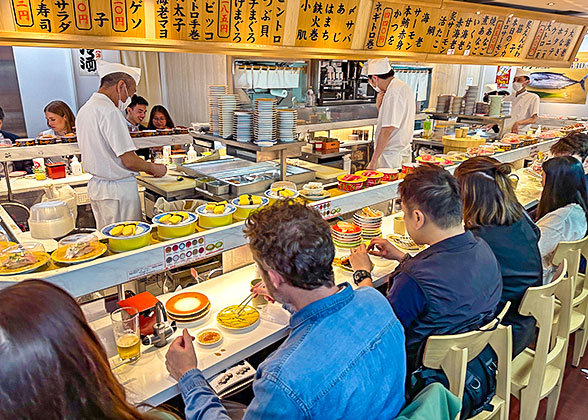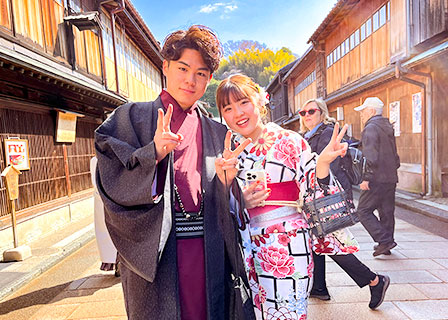Aoshima Island, Miyazaki
Located in the southeast of Miyazaki, Aoshima is a landward island connected with Honshu, the biggest island of Japan, by Yayoi Bridge. It’s not big and the total coastline is only around 1.5 kilometers (1 mile). But you will get close to more than 5, 000 subtropical plants here. It’s also the location of an ancient shrine. Besides, you can admire peculiar strata and try surfing on the waters around Aoshima. With all the above aspects, Aoshima has become a wonderful island for a one-day trip and for visitors to get away from the hustle and bustle of life and relax.
|
|
|
Top Things to Do on Aoshima
Visit Aoshima-jinja Shrine
Situated in the center of Aoshima, Aoshima-jinja Shrine dates back to around AD 820. Common people were not allowed to go on the island to pray in Aoshima-jinja Shrine until around 270 years ago. At that time, the shrine was seen as a sacred place, and therefore only priests and officers could go there and participate in the sacrifice rituals.On the way to Aoshima-jinja Shrine, you will pass under a red door. It’s more like an archway rather than a common door. The archway is called “torii” in Japanese, and it stands for the entrance to a god’s domain.
The worship hall enshrines three gods who are respectively in charge of marriage, birth, and navigation. It’s said that a god couple in Japanese myth got married in Apshima-jinja Shrine, so the shrine attracts numbers of couples and women to come here to pray for a happy marriage or early arrival of true love. If you are lucky, you may see a traditional Japanese wedding held in the shrine.
After visiting the main shrine, do not forget to come to Motomiya, a red pavilion near the main shrine. The path leading to the Motomiya Shrine is lined with lush subtropical plants. Walking on the path, you will feel like wandering into a jungle.
As you walk, you will approach the red shrine pavilion. You can find colorful strips called “koyori” tied to the trees in front of Motomiya. “Koyori” is a kind of twisted paper strip used by Japanese to make wishes to god. Different colors stand for different meanings: pink paper strips mean praying for a harmonious marriage, purple is for health, green for a successful career, yellow for booming business, and white for other wishes. Try to make a wish and leave your strip when you come here.
Admire Devil’s Washboard
Part of the reason why Aoshima is so special comes from the Devil’s Washboard. It refers to a unique terrain that looks like a washboard. The layers of wavy rocks spread along the coastline. The landscape of the washboard is completely natural, and scientists attribute the phenomenon to a long time of seawater erosion. There used to be two kinds of strata piling on each other layer upon layer: one kind is easy to disintegrate, but the other is the opposite. After years of years’ erosion, only the stratum that is difficult to disintegrate remains, which consists of Devil’s Washboard.When the tide is out, you can stand on the grotesque rocks and enjoy the landscape closely. Remember to be careful of the reef and waves.
Enjoy Surfing
The waves on the sea around Aoshima are perfect for surfing. A lot of international surfing campaigns have been held on the waters around Aoshima. There are at least 6 surfing schools, which provide not only surfboards but also surfing training and other related services. No matter if you are a pro or an amateur, you will have a good time surfing here. Besides, if you want to surf in warm water, it’s recommended that you come here during August to November.

Riding Scooter in Aoshima Waters
|
Summer Festival in Aoshima-jinja Shrine
Several festivals are held in Aoshima-jinja Shrine, and the most special one is the summer festival. It is held on the 17th and 18th days of the 6th month in the lunar calendar every year. The young parishioners, at the age of 22 or 23, are the organizers of the procession of Mikoshi, a palanquin transporting a deity from one shrine to another. The festival is also called “Sea Crossing Festival” because Mikoshi will be placed on a fishing boat and go around the island on the sea.This is the busiest festival in a whole year. Dozens of ships with huge flags will sail following the ship carrying Mikoshi, which can be a unique travel experience for visitors.
How to Get Here
By Train
Take the Nichinan Line from Miyazaki Station to Aoshima Station. It takes about 30 minutes and the train ticket is 370 yen. After getting off, walk for less than 10 minutes towards northeast and then come across Yayoi Bridge to reach Aoshima.By Bus
There are buses heading to Aoshima from Miyazaki Station every hour. The drive will be 50 minutes, and a one-way ticket is 720 yen.Nearby Attractions
Miyako Botanic Garden, Aoshima
On the way leaving Aoshima Island, you can drop by Miyako Botanic Garden. Located to the southwest of Aoshima Island, the garden will help you know more about the subtropical plants. You will enjoy subtropical flowers that grow naturally in Aoshima, such as Jacaranda and Bougainvillea. There are also greenhouses with fruit trees like guava.Aoshima Beach Park
Across the Yayoi Bridge, Aoshima Beach Park is filled with people coming to relax. Here are beach umbrellas and benches for people to take a rest and enjoy the beautiful view of beach and sea.You May Like
-
 7 Days Mini Group Tour with Highlights in Japan: Tokyo - Mt. Fuji - Kyoto - Nara - Osaka from USD2155
7 Days Mini Group Tour with Highlights in Japan: Tokyo - Mt. Fuji - Kyoto - Nara - Osaka from USD2155 -
 10 Days Private Tour of Tokyo - Mt. Fuji - Nagoya - Takayama - Shirakawa-go - Kanazawa - Kyoto - Nara - Hiroshima - Osaka from USD3809
10 Days Private Tour of Tokyo - Mt. Fuji - Nagoya - Takayama - Shirakawa-go - Kanazawa - Kyoto - Nara - Hiroshima - Osaka from USD3809 -
 8 Days Japan Mini Group Tour to Tokyo - Hakone & Mt. Fuji - Kyoto - Nara - Osaka - Hiroshima - Osaka from USD2771
8 Days Japan Mini Group Tour to Tokyo - Hakone & Mt. Fuji - Kyoto - Nara - Osaka - Hiroshima - Osaka from USD2771


